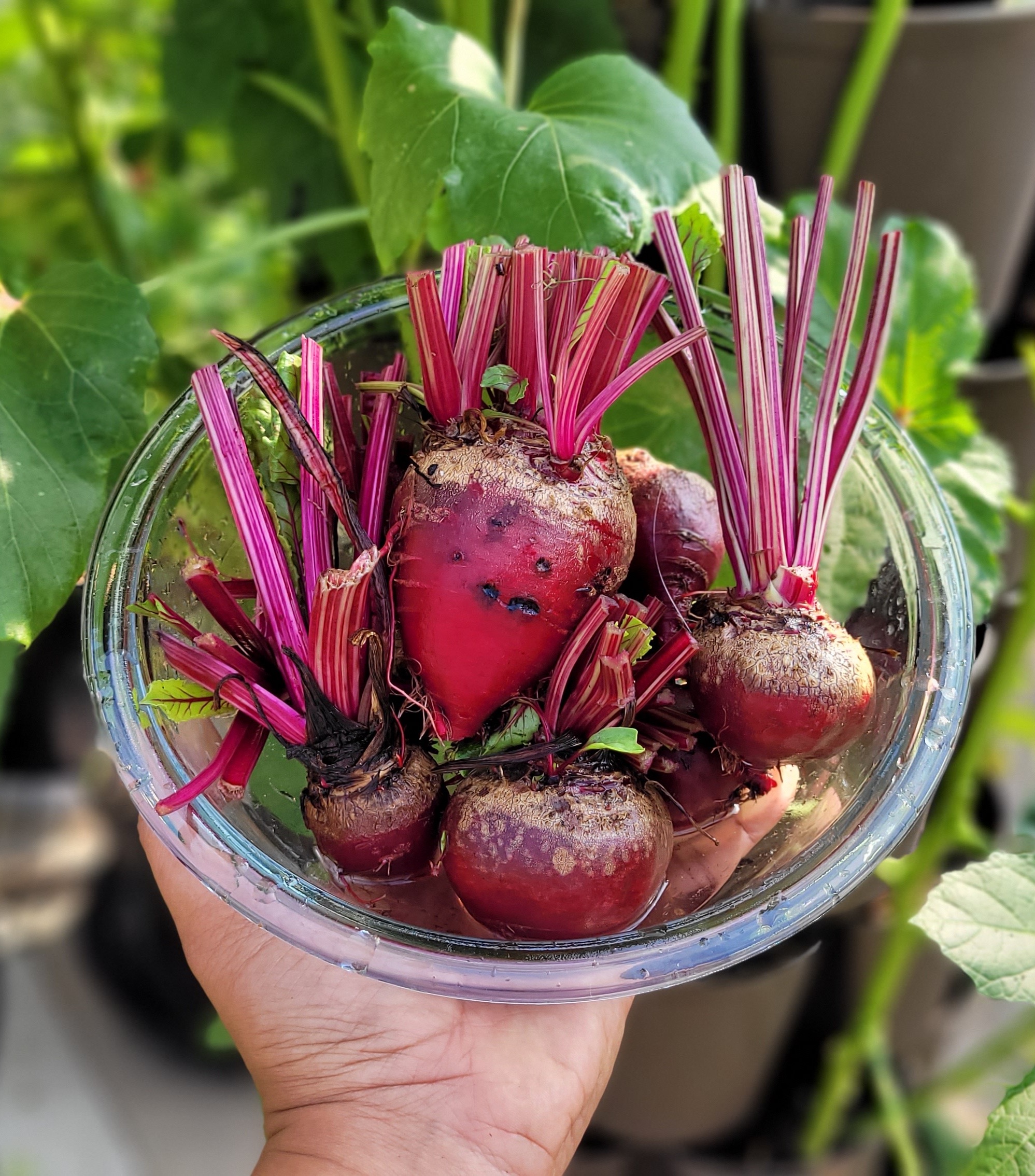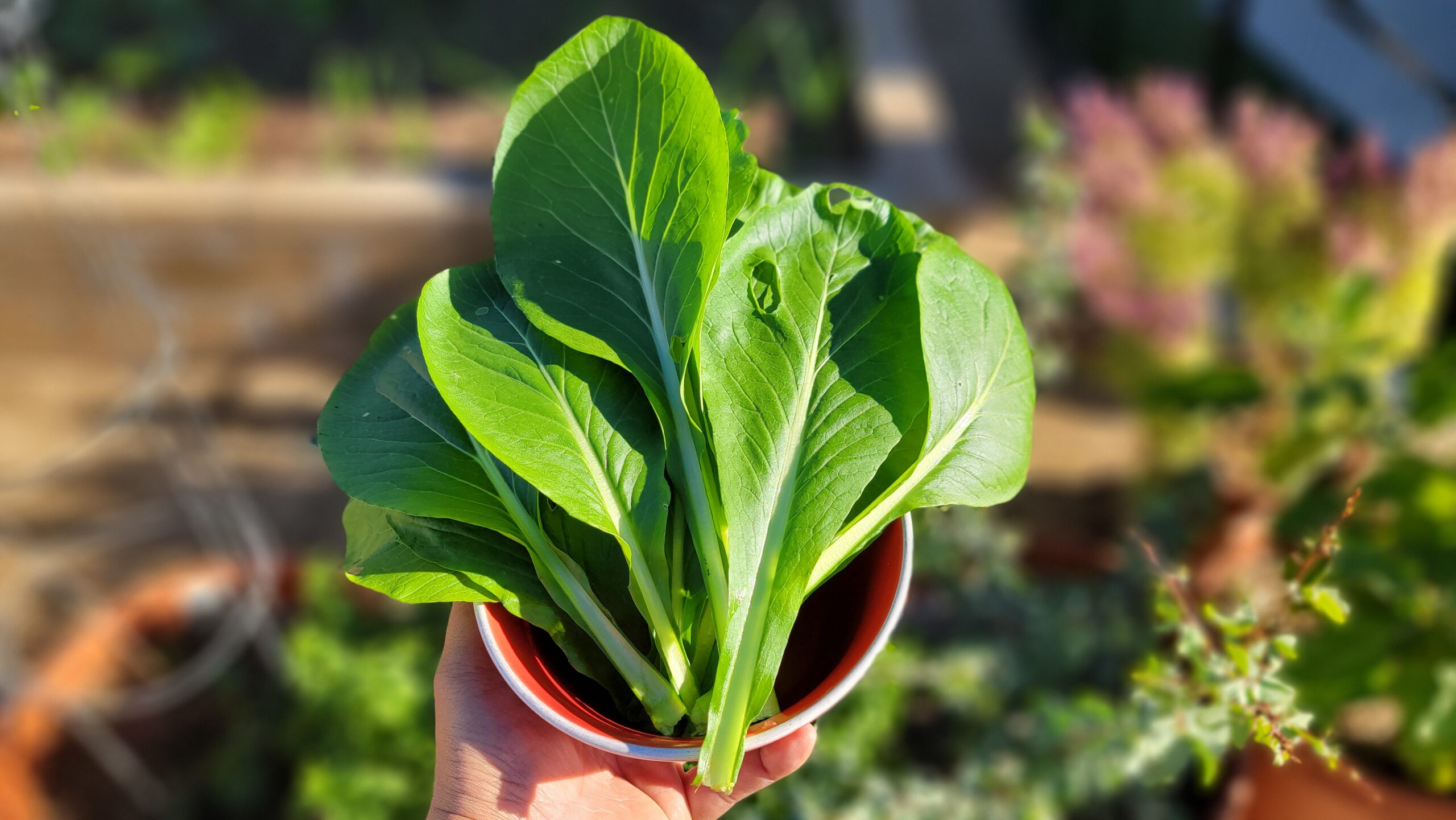
Bountiful harvest we made this month, a tour of the California Garden, some things for you to do, and more in today’s episode of California Gardening!
Harvests
We had a good harvest this month. Plants included apples, bitter gourds, cucumbers, guavas, hyacinth beans, ivy gourds, lemons, lettuce, moringa, okra, pineapple, pomegranate, radish, spinach, sunchokes, and tomatoes.
We have a few apple trees growing – due to the Santa Ana winds, all our apples fell down, which were ripe, sweet, and very delicious. Dwarf bitter gourds were towards the end of the season. The ones in the container were still producing, which is what we harvested this month.
Our Japanese cucumbers were still producing in November and this is the last crop of cucumbers that we harvested from this plant growing in a container. As usual, the Japanese cucumbers are absolutely delicious. They’re very crunchy and easy to grow. This is going to be our final harvest of Japanese cucumbers for the season.
We were growing a couple of guava varieties, including the tropic red and tropic white. The tropic red variety, or tropic pink, has a nice, rich, deep pinkish red flesh. It does have large seeds and it’s not too sweet, but it still has a nice tropical flavor and fragrance, which makes it great to eat raw or even make smoothies with. However, if you’re looking for sweeter guavas than the tropic red or even store-bought guavas, the tropic white variety is the way to go. We had so many guavas that the branches fell over! The guavas are very nice and crunchy with a sweet flavor.
We have our hyacinth bean plant growing along our wall, and we harvested a lot of hyacinth beans in the previous month. The plant became extremely tall to the point that a ladder was needed to harvest the beans! Hyacinth beans are very crunchy, fresh, and flavorful when they’re from your backyard rather than from the store. These beans must be cooked before you eat them.




The ivy gourd, or tindora plant was growing on the trellis on our last raised bed. We’ve harvested a lot from this plant throughout the summer season, and November is the last month that it’ll yield a lot. We had Meyer lemons growing in the ground, and a lot of lemons were growing. Meyer lemons aren’t very tart; in fact, they have a nice flavor that’s great for lemonade and quite good in taste.
We were growing lettuce in a container, and they started to bolt because of the hot weather that we’ve had in November. So, to harvest this lettuce, we just cut the top part of the stem out and use these leaves now and juice them because they have a lot of minerals and vitamins.
We harvested not only the leaves of the moringa plant, but we also harvested the pods. The moringa pods are absolutely delicious when cooked in a dish called sambhar.
Our jambalaya okra was still producing in November. It starts producing very early and continues producing late in the season, which is quite unique for this variety. This is an excellent variety that produces a lot on a relatively small plant.
We had our pineapple plants growing in a container. Something nice is when the pineapple plant is ripe you can just snap it off the stem and it should come off easily. The top of the pineapple can actually be planted back into a different plant: if you plant it in soil or keep it in a glass of water it will send out roots, which can be planted as a new plant!
We were growing the parfianka pomegranate variety in our garden and it produced large pomegranates. It has nice dark seeds full of antioxidants, vitamins, and minerals that are very good for your health. Of course, they’re also really sweet and juicy, perfect for eating raw, juicing, or in a salad.
We were growing several radish varieties in our garden, including the pink daikon, royal purple, and black spanish varieties. The royal purple variety of radish in our raised beds was a new variety we grew for 2021, and it was full of anthocyanins, meaning it has a lot of vitamins and minerals that are great for your health. The black spanish radish is a very pungent variety with a strong radish flavor. These radishes grow very quickly and abundantly, and they don’t need any fertilizer. Our soil just contains a lot of compost and a lot of worm castings to make the soil more fertile.




Mustard spinach was a new variety that we were growing this year. Mustard spinach is a variety that has a subtle flavor of mustard. There is an Indian dish called sarson ka saag which involves both spinach and mustard in the recipe, but if you grow mustard spinach you can just use the mustard spinach leaves and make this dish. These leaves taste amazing in a salad and they are quite flavorful.
We were growing our sunchokes in a container and they produced a lot of tubers. We recommend that you grow sunchokes in containers because the plant can get very invasive when growing in a shared bed. Some of the sunchokes will be discarded because they are green in color, which you shouldn’t eat.
We grew determinate tomato plants and San Marzano tomatoes in a container. The plant was surprisingly still very much alive in November, which must’ve been due to the unusual weather we’ve had in late Autumn.
Garden Tour
In the first raised bed, we have a lot of onions and radish growing. All the bean plants that we planted were totally destroyed by the Santa Ana winds. The tomatoes are growing well, with quite a lot of tomatoes being produced on the plant. Our pole bean plants have managed to survive the winds and are growing on a trellis. We also planted some brassicas, including cabbage, cauliflower, and broccoli. The Santa Ana winds have destroyed a couple of brassicas so we will replant them.
We’re also growing beets and eggplants, specifically the black moon eggplant. It’s still producing an eggplant, and once again due to the Santa Ana winds one of the branches snapped off, but hopefully it will survive. We planted a lot of kale, which will be used for salads and juicing.
We also have a lot of red cabbages growing, and some bunching onions on the side. Finally, we have our ivy gourd plant on the trellis and that’s all for the raised beds.


Let’s now move on to the containers. We have broccoli and we sowed some carrot seeds. We also have our suraj mukhi pepper plant and atomic red carrots. We have radishes that are growing really well, and also some bush roma tomatoes. We also have our taro root plant that’s growing well. We replaced all the saucers for our containers with the GreenStalk spinner, which allows the water to drain back into the planter area.
We also have lettuce growing in the next container, followed by onions and the giloy plant. We have cardamom, and we’ve finally trimmed down our mint plant completely so that it regrows vigorously, which is the whole idea of trimming down your mint plants in the winter. Our guava tree’s branches have all fallen down because of the amount of fruits that have grown. We have our turmeric plant and mustard spinach plant that was part of our harvest this month. We also had our San Marzano tomato plant which is also growing well and producing a lot of tomatoes. We have our bunching onions, black moon eggplant, hyacinth beans, peas, and bush glacier tomatoes as well.
On the next container we have some more brassicas. Our cauliflowers are growing quite well. The Meyer lemon and curry leaf plant are also all growing quite well. Our pineapple guava plant and our ivy gourd plant are nearby too, but now it’s the end of the season for the ivy gourd. Our pigeon pea plant was flowering, but again due to the Santa Ana winds, it’s not looking that good. Last, we have our java plum plant.


And now let’s look at some things to do in your garden, starting with setting up hoops or netting for your raised beds. We put some rebars for our raised bed, and the number of rebars should be twice the number of hoops that you want. We used two foot rebars and put them in the ground until they went all the way inside leaving about a foot outside. As long as the rebar is firmly fixed in the ground, you should be fine. One of the benefits of adding these hoops and the netting is that you don’t need to use any pest control. We used Plex pipes instead of PVC pipes because they are easier to cut and are less rigid, and just pushed them into the rebar and then through the other side of the rebar to create a hoop and this is enough to support the netting. You can add the netting on the top and once everything is completed, this will protect your plants from insects, diseases, or even strong winds.
The next tip is to trim your mint plant. In the winter season the mint plants will have leaves that are not so good, so at the end of the winter, you should just chop up the mint plant all the way to the surface. What this does is it lets the plant come back vigorously once you start watering the plant and adding nutrients in the winter. In the spring season, it will come back very strong and you will have really good quality mint that you can harvest.
Happy Gardening! Watch our complete video at California Gardening November 2021 Harvests, Garden Tour, Gardening Tips, Things To Do & More!

0 Comments